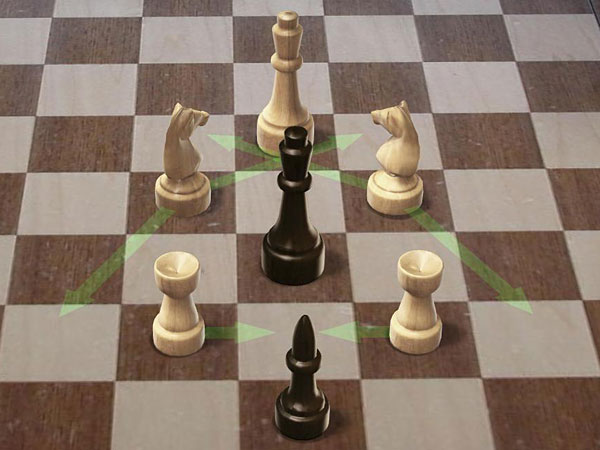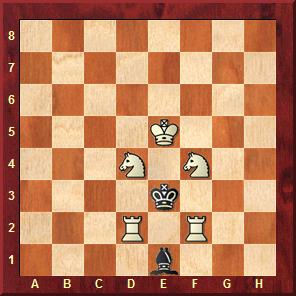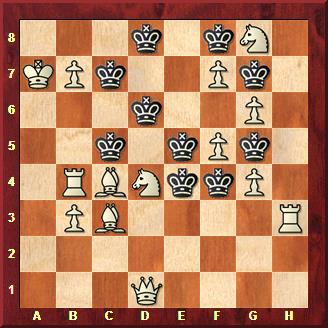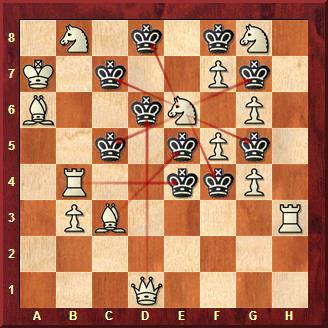


On the first of April Pal Benko, the world-famous GM and problem composer, one to the greatest in the field, sent us a number of humorous problems. He called his piece "April Swindles", and if you missed it you can try solving them here. The solutions are given below the problems themselves. The first two represent the numbers 8 and 8, and stand for the age of the composer.
 |
 |
Problem 1: For both positions the question is: how many mates are there for White in one move. The first problem is for kids, the second one is for adults – it needs some thought. In both cases: what was the last move, before the diagram?

Problem 2a: On how many squares can you put the black king so that White can mate in one move. And Problem 2b: Where can you put the black king so it is White to play and mate in two? We found these two problems unexpectedly difficult.

Problem 3: On how many squares can you place the white queen, so that, with Black to play, he can mate in one move, in two different ways?

Problem 4a: White to play, helpmate in three (i.e. both sides cooperate to get Black mated in three moves). Problem 4b: Second solution, White to play, helpmate in three. Here you have to consider the previous move by Black.

Problem 5a: Black to play, White checkmates all ten black kings, simultaneously, in two moves. Problem 5b: White to play, checkmates all ten black kings, simultaneously, in three moves.
The solutions to problem 5 cannot be easily displayed on our JavaScript PGN player, which worries about "legality" or something like that. The solutions are:
1.K8d7 Bb5+ 2. Kdd6 Ne6#
1.b8N! Kdc8 2. Ba6+ K8d8 3. Ne6#!

All ten black kings are checkmated (problem 5b)

In an article entitled "On human and computer intelligence in chess" we presented the reaction of Miguel Illescas, a top Spanish GM and trained computer scientist, to a chess position published by famous mathematics professor Sir Roger Penrose. Miguel included a challenge:
Our readers were invited to analyse the above position, here on our news page, or with their favourite chess engine, to solve it with machine assistance. A number did, and in fact provided interesting feedback on the fortress theme. Here is the solution as provided by Miguel Illescas:

[Event "Fortress study"] [Site "?"] [Date "2017.03.20"] [Round "?"] [White "Illescas, Miguel"] [Black "White to play and draw"] [Result "1/2-1/2"] [Annotator "Illescas,Miguel"] [SetUp "1"] [FEN "1r6/1n1R1b2/8/1p1p3k/pPpPp1p1/2P1P3/P2K1PP1/8 w - - 0 1"] [PlyCount "27"] [EventDate "2017.??.??"] 1. Rxb7 $3 (1. Rxf7 g3 $1 2. fxg3 Nd6 3. Rf6 Rd8 4. Ke2 Kg5 {with advantage for Black.}) 1... Rf8 $1 (1... Rxb7 2. g3 $1 Kg5 3. Ke2 Rb6 4. Kf1 Rh6 5. Kg2 { Draw.}) 2. g3 $1 Kg6 $1 3. Rb6+ $1 (3. Ke2 Rh8 4. Rxb5 Rh1 5. Ra5 Be8 $1 { with advantage for Black.}) 3... Kg7 4. Rh6 $3 Kxh6 5. Ke2 $1 Kg5 6. Kf1 $1 Rh8 7. Kg2 a3 8. Kg1 $1 Ra8 9. Kg2 Ra4 10. Kf1 $1 Be6 11. Ke1 Ra8 12. Kf1 $1 Bf7 13. Kg2 Ra4 14. Kf1 {Draw.} 1/2-1/2

[Event "Fortress study"] [Site "?"] [Date "2006.05.07"] [Round "?"] [White "Illescas, Miguel"] [Black "White to play and draw?"] [Result "*"] [Annotator "Illescas,Miguel"] [SetUp "1"] [FEN "1r6/1nR2bp1/7k/1p1p4/pPpPp1p1/P1P1P3/3K1PP1/8 w - - 0 1"] [PlyCount "4"] [SourceDate "2006.05.01"] {This was my original study in 2006. I first thought that} 1. Rxb7 $1 {makes a draw} (1. Rxf7 g3 $1) {but Black can play} 1... Rf8 $3 ({After} 1... Rxb7 2. g3 $1 Rb6 3. Ke2 Kg5 4. Kf1 Rh6 5. Kg2 $11 {[%csl Rf7,Rg5][%cal Rh6h1]}) {White still tries} 2. g3 $1 {but after} (2. Ke2 g3 $1) 2... Kg6 $1 {the black rook will reach h1 one day and White is definitely worst.} *
The solutions to the Nihal Sarin problems will follow soon!